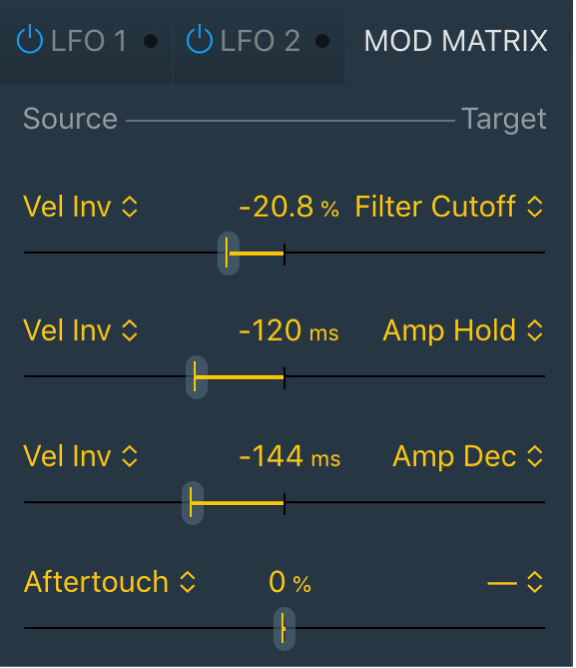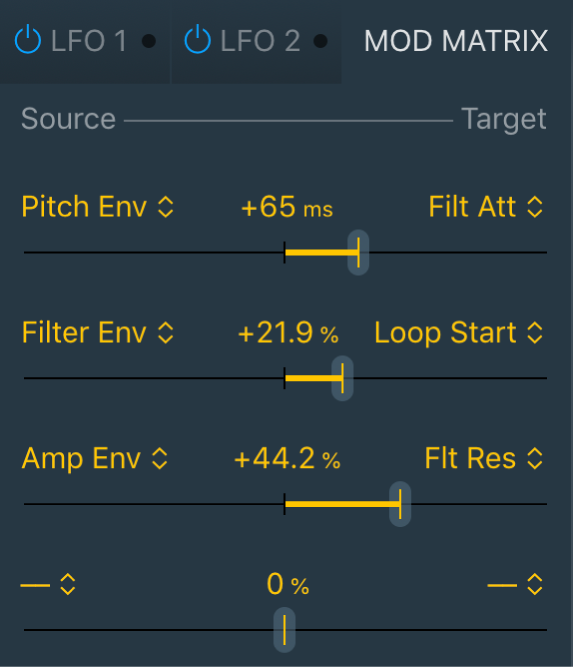MainStage User Guide
- Welcome
-
- Overview of Edit mode
-
- Select patches and sets in the Patch List
- Copy, paste, and delete patches
- Reorder and move patches in the Patch List
- Add and rename patches
- Create a patch from several patches
-
- Overview of the Patch Settings Inspector
- Select patch settings in the Patch Library
- Set the time signature for patches
- Change the tempo when you select a patch
- Set program change and bank numbers
- Defer patch changes
- Instantly silence the previous patch
- Change patch icons
- Transpose the pitch of incoming notes for a patch
- Change the tuning for a patch
- Add text notes to a patch
-
- Overview of channel strips
- Add a channel strip
- Change a channel strip setting
- Configure channel strip components
- Show signal flow channel strips
- Hide the metronome channel strip
- Create an alias of a channel strip
- Add a patch bus
- Set channel strip pan or balance positions
- Set channel strip volume levels
- Mute and solo channel strips
- Use multiple instrument outputs
- Use external MIDI instruments
- Reorganize channel strips
- Delete channel strips
-
- Overview of the Channel Strip Inspector
- Choose channel strip settings
- Rename channel strips
- Change channel strip colors
- Change channel strip icons
- Use feedback protection with channel strips
- Set keyboard input for a software instrument channel strip
- Transpose individual software instruments
- Filter MIDI messages
- Scale channel strip velocity
- Set channel strips to ignore Hermode tuning
- Override concert- and set-level key ranges
- Add text notes to a channel strip in the Channel Strip Inspector
- Route audio via send effects
-
- Screen Control Inspector overview
- Replace parameter labels
- Choose custom colors for screen controls
- Change background or grouped screen control appearance
- Set screen controls to show the hardware value
- Set parameter change behavior for screen controls
- Set hardware matching behavior for screen controls
- Reset and compare changes to a patch
- Override concert- and set-level mappings
-
- Overview of mapping screen controls
- Map to channel strip and plug-in parameters
- Map screen controls to actions
- Map a screen control to multiple parameters
- Use screen controls to display PDF document pages
- Edit the saved value for a mapped parameter
- Set drum pads or buttons to use note velocity
- Map screen controls to all channel strips in a patch
- Undo screen control parameter mappings
- Remove screen control mappings
- Work with graphs
- Create controller transforms
- Share patches and sets between concerts
- Record the audio output of a concert
-
- Overview of concerts
- Create a concert
- Open and close concerts
- Save concerts
- How saving affects parameter values
- Clean up concerts
- Consolidate assets in a concert
- Rename the current concert
-
- Overview of the Concert Settings Inspector
- Set MIDI Routing to channel strips
- Transpose incoming note pitch for a concert
- Define the program change message source
- Send unused program changes to channel strips
- Set the time signature for a concert
- Change the tuning for a concert
- Set the pan law for a concert
- Add text notes to a concert
- Control the metronome
- Silence MIDI notes
- Mute audio output
-
- Layout mode overview
-
- Screen control parameter editing overview
- Lift and stamp screen control parameters
- Reset screen control parameters
- Common screen control parameters
- Keyboard screen control parameters
- MIDI activity screen control parameters
- Drum pad screen control parameters
- Waveform screen control parameters
- Selector screen control parameters
- Text screen control parameters
- Background screen control parameters
- How MainStage passes through MIDI messages
- Export and import layouts
- Change the aspect ratio of a layout
-
- Before performing live
- Use Perform mode
- Screen controls in performance
- Tempo changes during performance
- Tips for performing with keyboard controllers
- Tips for performing with guitars and other instruments
- Tune guitars and other instruments with the Tuner
- The Playback plug-in in performance
- Record your performances
- After the performance
- Tips for complex hardware setups
-
- Overview of keyboard shortcuts and command sets
-
- Concerts and layouts keyboard shortcuts
- Patches and sets (Edit mode) keyboard shortcuts
- Editing keyboard shortcuts
- Actions keyboard shortcuts
- Parameter mapping (Edit mode) keyboard shortcuts
- Channel strips (Edit mode) keyboard shortcuts
- Screen controls (Layout mode) keyboard shortcuts
- Perform in Full Screen keyboard shortcuts
- Window and view keyboard shortcuts
- Help and support keyboard shortcuts
-
-
- Use MIDI plug-ins
-
- Arpeggiator overview
- Arpeggiator control parameters
- Note order parameters overview
- Note order variations
- Note order inversions
- Arpeggiator pattern parameters overview
- Use Live mode
- Use Grid mode
- Arpeggiator options parameters
- Arpeggiator keyboard parameters
- Use keyboard parameters
- Assign controllers
- Modifier controls
- Note Repeater controls
- Randomizer controls
-
- Use Scripter
- Use the Script Editor
- Scripter API overview
- MIDI processing functions overview
- HandleMIDI function
- ProcessMIDI function
- GetParameter function
- SetParameter function
- ParameterChanged function
- Reset function
- JavaScript objects overview
- Use the JavaScript Event object
- Use the JavaScript TimingInfo object
- Use the Trace object
- Use the MIDI event beatPos property
- Use the JavaScript MIDI object
- Create Scripter controls
- Transposer controls
-
-
- Alchemy overview
- Alchemy interface overview
- Alchemy Name bar
- Alchemy file locations
-
- Alchemy source overview
- Source master controls
- Import browser
- Source subpage controls
- Source filter controls
- Source filter use tips
- Source elements overview
- Additive element controls
- Additive element effects
- Spectral element controls
- Spectral element effects
- Pitch correction controls
- Formant filter controls
- Granular element controls
- Sampler element controls
- VA element controls
- Wide unison mode
- Source modulations
- Morph controls
- Alchemy master voice section
- Alchemy Extended parameters
-
- Playback plug-in overview
- Add a Playback plug-in
- Playback interface
- Use the Playback waveform display
- Playback transport and function buttons
- Playback information display
- Playback Sync, Snap To, and Play From parameters
- Use the Playback group functions
- Use the Playback Action menu and File field
- Use markers with the Playback plug-in
-
- Sample Alchemy overview
- Interface overview
- Add source material
- Edit mode
- Play modes
- Source overview
- Synthesis modes
- Granular controls
- Additive effects
- Additive effect controls
- Spectral effect
- Spectral effect controls
- Filter module
- Lowpass, bandpass, and highpass filters
- Comb PM filter
- Downsampler filter
- FM filter
- Envelope generators
- Mod Matrix
- Modulation routing
- Motion mode
- Trim mode
- More menu
-
- Sculpture overview
- Sculpture interface
- Global parameters
- Amplitude envelope parameters
- Use the Waveshaper
- Filter parameters
- Output parameters
- Define MIDI controllers
- Extended parameters
-
- Studio Piano
- Copyright

Quick Sampler Mod Matrix pane in MainStage
Quick Sampler LFOs and envelopes are known as modulation generators. These modulation sources are used to control modulation targets, such as oscillator pitch or filter cutoff.
You can assign up to four independent routings of modulation sources and targets in the Mod Matrix pane.
If you’re new to synthesizers and the concepts behind modulation generators, such as LFOs and envelopes, see Synthesizer basics overview.
Quick Sampler provides two LFOs and dedicated Pitch, Filter, and Amplitude envelopes that can also be assigned as modulation sources or targets in the Mod Matrix pane.
Your keyboard modulation wheel, aftertouch, pitch bend, velocity, and MIDI continuous controller features can also be assigned as real-time control sources for Quick Sampler parameters in the Mod Matrix.

Mod Matrix parameters
Source pop-up menu: Choose a modulation source.
Target pop-up menu: Choose a modulation target.
Amount slider: Set the maximum value or intensity of modulation.
Set up a modulation routing
You can assign Quick Sampler LFOs and envelopes as modulation sources or targets in the Mod Matrix pane.
You can also assign your keyboard modulation wheel, aftertouch, pitch bend, velocity, and MIDI continuous controllers as real-time control sources for Quick Sampler target parameters in the Mod Matrix pane.

In the Mod Matrix pane:
Choose a modulation target from the Target pop-up menu.
Choose a modulation source from the Source pop-up menu.
As an example: Use Velocity Inverted to modulate a target with a soft keystrike, and no modulation when struck firmly.
Note: The envelope modulators shown in the image are hard-wired to control Pitch, Filter, and Amplitude, but you can also assign them as sources to modulate other Quick Sampler parameters in the Mod Matrix pane. The envelopes and LFOs are also available as modulation targets.
Set the maximum value or intensity of modulation with the Amount slider.
Set up a modulation routing of sample or loop start and end, or loop position
The Sample Start & End, Loop Start & End, and Loop Position targets can be quantized in musical values. For example, if you modulate the loop position (the entire loop) using an LFO, a quantization of one bar moves the loop back and forth along the time line in one bar increments instead of the usual smooth LFO motion.
You could also choose to assign your keyboard modulation wheel as a real-time control source for Loop Position, or perhaps to Sample Start or Loop Start, providing you with direct, physical control of these parameters.
In the Mod Matrix pane:
Choose an LFO from the Source pop-up menu.
Choose a Sample Start or End, Loop Start or End, or Loop Position option from the Target pop-up menu.
The quantization value you choose in the modulation Target pop-up menu applies to all modulation routings assigned to this target.
Sample Start or End: Choose None, or Bar, Beat, or Triplet values to rhythmically modulate the sample start or end position.
Loop Start or End: Choose None, or Bar, Beat, or Triplet values to rhythmically modulate the loop start or end position.
Loop Position: Choose None, or Bar, Beat, or Triplet values to rhythmically modulate the loop position.
Set the amount of modulation with the Amount slider.
As an optional second modulation routing, set up your keyboard modulation wheel (Mod Wheel) as the source, and Loop Start as the target.